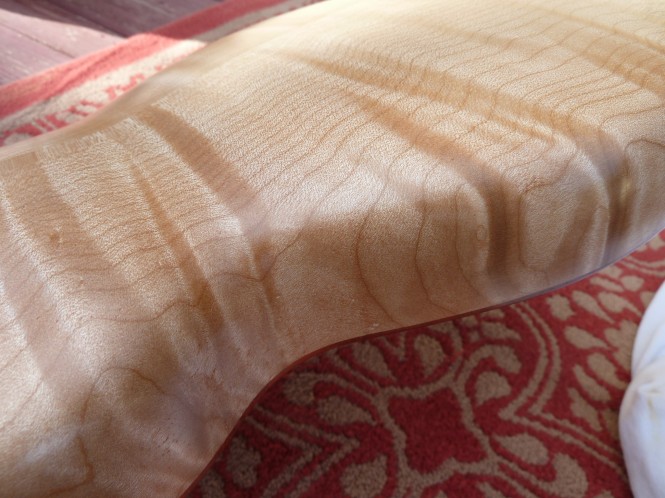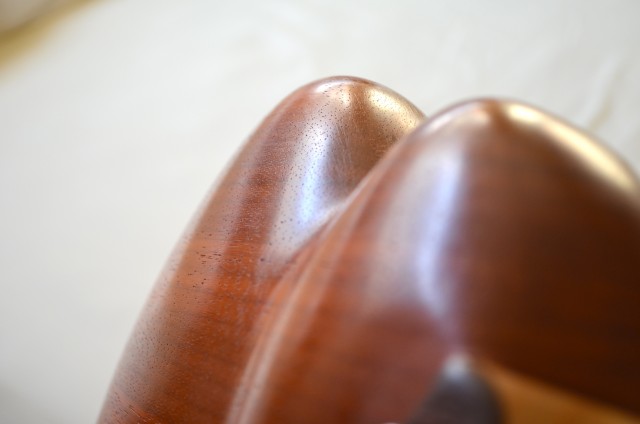woods
Exotic woods are often the primary focus in building custom ukuleles, but perhaps they shouldn’t be. We’ve always felt that the best way to choose an ukulele is to play it with your eyes closed. That way you can focus on the tone and how it feels in your hands. The ukulele that sounds the best to you and feels the most comfortable in your hands as you play it is arguably the best one for you. When we choose our woods we focus first on tone, then on the necessary characteristics that a wood must have for specific applications in the build (grain structure, weight, rigidity, density, durability, workability, etc.). We then look at the practical aspects of cost and availability. And finally whether we are being responsible to the Earth and to future generations in our wood choices.
We’re trying to reduce our use of rare/endangered hardwoods. While they are beautiful, they are becoming scarce and so we are trying to use them less in hopes they’ll survive for posterity. Perhaps part of the beauty in our ukuleles is knowing that they do use simpler, more common woods. As long as we can get beautiful tone, we’d like to spare the trees.

Poplar
Nearly all our bentwood acoustic bodies are made of simple Poplar. It’s a very common wood that performs wonderfully and is quite beautiful as well. It has a remarkable range of colors. It can be nearly white, usually with a tinge of green which looks lightly gold when it’s finished. It can be boldly streaked with purplish brown stripes caused by mineral staining as the trees grow. And it can be nearly purple/black when it has a lot of mineral staining. It can be almost completely without figure or it can be highly figured. It has to be one of the most varied woods around. Perhaps not exotic, but it certainly has personality and that suits our ukuleles just fine because we want our ukuleles to have personality just like their owners.

Mahogany & Sapele
We often use Mahogany or Sapele for our necks. These woods are not as common as Poplar, but necks require specific characteristics that these woods have and until we find a suitable replacement we use these. Quartersawn Mahogany and Sapele are very strong while being surprisingly lightweight. These characteristics are perfect for necks. The strength makes them very rigid and the lightweight give our ukes outstanding balance in your hands.

Maple (Quilted, Birdseye & Curly)
Maple is an oft-requested wood because it can be wildly figured. It’s Earth-friendly and produces quite a bright tone. It is very dense and so we tend to make our Maple soundboards thinner. A completed ukulele in Maple tends to take a bit longer to fully develop its voice.

Western Red Cedar
Western Red Cedar is fairly non-descript looking but has magnificent tone. We rarely get orders for it but when we go to shows where people can play and hear them, they sell very well. Cedar feels like and handles similar to Redwood, It’s very lightweight and has a definite springy feel. Loud, rich-toned with an understated look which is why it is one of our favorite tonewoods.

Ancient “Mammoth” Kauri
Mammoth Kauri is a wood from Northern New Zealand. It is actually recovered from ancient peat bogs where it has been buried for thousands of years. It is the oldest known workable wood and many specimens have been carbon dated at more than 50,000-years old. Most wood this old is petrified and unworkable. The trees that produced this wood were growing prior to the last two ice ages, when wooly mammoths roamed the Earth, hence the colloquial name, “Mammoth” Kauri. Kauri is certainly one of our favorite tonewoods. It just sounds incredible. It’s loud, not too bright and not too mellow. It’s just right… and beautiful too. It ranges in color from an incredible golden yellow to a dark brooding brunette. We can only get it once in awhile.

Padauk
Padauk is one fairly exotic wood that we occasionally use. We were gifted a beautiful quartersawn plank and use it for special builds. Padauk is extremely rigid and dense with an amazing spring to it. When you thin it to soundboard thickness and tap it, it rings like a bell. Extraordinary. Unfortunately it is becoming quite rare.
